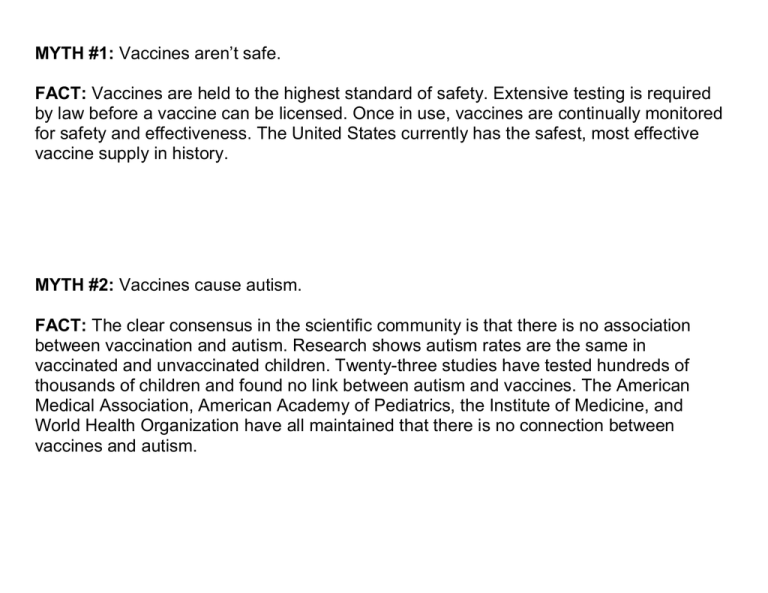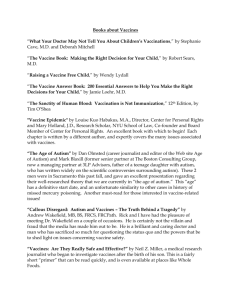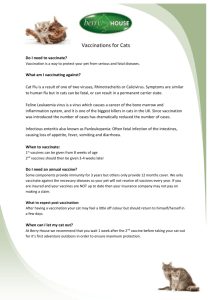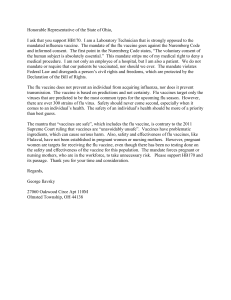MYTH #1: FACT: Vaccines aren’t safe.
advertisement

MYTH #1: Vaccines aren’t safe. FACT: Vaccines are held to the highest standard of safety. Extensive testing is required by law before a vaccine can be licensed. Once in use, vaccines are continually monitored for safety and effectiveness. The United States currently has the safest, most effective vaccine supply in history. MYTH #2: Vaccines cause autism. FACT: The clear consensus in the scientific community is that there is no association between vaccination and autism. Research shows autism rates are the same in vaccinated and unvaccinated children. Twenty-three studies have tested hundreds of thousands of children and found no link between autism and vaccines. The American Medical Association, American Academy of Pediatrics, the Institute of Medicine, and World Health Organization have all maintained that there is no connection between vaccines and autism. MYTH #3: Combination vaccines or multiple vaccines given at the same time are dangerous. FACT: Before combination vaccines are licensed for use, extensive studies are done to ensure safety and effectiveness. Similar studies are done before multiple vaccines are recommended to be given at the same time. Both practices are safe. MYTH #4: There is a lot of mercury (thimerosal) in vaccines, which is dangerous. FACT: Extensive research has failed to show any consistent link between thimerosal in vaccines and any health condition including autism. Thimerosal was removed from all routine child vaccines in 2001. Despite the removal of thimerosal from childhood vaccines, autism rates have continued to rise. This is the opposite of what would be expected if thimerosal caused autism. MYTH #5: We don’t need to vaccinate kids anymore for the same diseases we had as children. FACT: Recent history continues to demonstrate that when vaccination rates dip in the population, these diseases rebound. Small pox is the only disease that has been eliminated world-wide and against which we no longer need to be vaccinated. MYTH #6: Only children need vaccinations. FACT: Vaccine-preventable diseases continue to be a threat throughout our lives. Adolescents need boosters for many childhood diseases, some college age students need protection from meningitis, adults need vaccines for shingles and pneumonia, and everyone needs the flu vaccine and, especially for those around infants, the pertussis vaccine. MYTH #7: A "holistic" lifestyle will bolster our immune systems and protect us from disease. FACT: Certainly there are steps we can take to reduce our risk of contracting or getting seriously ill from vaccine preventable diseases, such as washing our hands and maintaining a healthy lifestyle. However, research has shown over and over that vaccination is by far the safest and most effective way to avoid infection with these diseases. MYTH #8: Only the elderly need to get vaccinated for the flu. FACT: Everyone 6 months old and older should get the flu vaccine. Flu vaccines are especially important for people who fall within high risk groups, including the elderly, pregnant women, young children, and individuals with certain underlying health conditions. Children are two-to-three times more likely to develop influenza than adults. The H1N1 influenza pandemic was a reminder of how serious influenza can be. MYTH #9: Getting vaccinated against the flu can actually give you the flu. FACT: The injectable flu vaccine does not contain live virus and cannot transmit the flu. The nasal spray flu vaccine includes a weakened form of the virus. The likelihood of experiencing any flu-like symptoms after receiving the vaccine is extremely low. MYTH #10: Too many vaccines can overwhelm the immune system. FACT: Before a vaccine is licensed, extensive studies are done to ensure that the vaccine produces an effective immune response and does not overwhelm the immune system when given alone, in combination with other vaccines, or, if necessary, in multiple doses over time. The current schedule of recommended vaccinations for all ages is perfectly safe for the vast majority of the population. Resource: California Department of Public Health Debunking vaccination Myths





